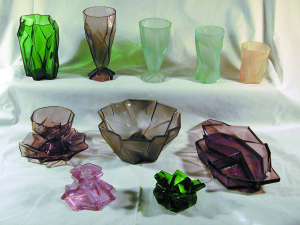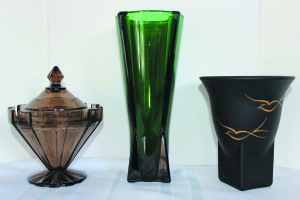 By Tom Cotter, January 13, 2015
By Tom Cotter, January 13, 2015
Born in Europe, migrating to the United States, and, arguably, climaxing with either a 1925 exhibit in Paris or with the New York World’s Fair in 1939 and the beginning of World War II, Art Deco was a glimpse into the past shot through with the 20th Century conversion to mechanization. According to Wikipedia, “It is an eclectic style that combines traditional craft motifs with Machine Age imagery and materials. The style is often characterized by rich colors, bold geometric shapes and lavish ornamentation.” The social and economic changes that comprised this period were perhaps even more astounding than the artistry produced. In the U.S., literacy surged from 80% in 1900 to 97% by 1950, while population nearly doubled from 76 to 151 million. And while rural populations grew from 46 to 54 million, mass urbanization caused cities to swell by over 320% from 30 to 97 million. Within this half century, travel moved from rails to automobiles to air, communication from early telephony to nearly universal service, entertainment from plays to radio to movies to instantaneous television. One of the great attractors of the U.S. Art Deco movement was its availability to nearly all of society. For France and Europe, it was an intellectual appetizer for the educated elite; in the U.S., design and production methods gave nearly everyone access to Art Deco products. Well, at least before and after the Great Depression. Encouraged by technological innovations in construction, skyscrapers dotted the great cities, from the Chrysler and Empire State Buildings in New York to the Bullocks Wilshire and the Pellissier Buildings of Los Angeles. Theaters in particular took on very unique appearances reflecting the historic aspect of Art Deco. In 1920s Los Angeles, Sid Grauman and Charles Toberman developed the Egyptian, El Capitan, and the Chinese Theatres as standards of the new imagery. In Denver, we have a tribute to Art Deco with the 1930 Mayan Theatre. Pottery flourished from coast to coast, including a number of Art Deco styles from Colorado’s Van Briggle, Coors, and Broadmoor potteries. My primary fascination is U.S.-made glass, so I hope this article will bring some information about that Art Deco medium to readers.
 In Denver, we are very, very fortunate to have access to one of the most comprehensive collections of late 19th and 20th century decorative art in the country at Kirkland Museum of Fine & Decorative Art. Kirkland Museum’s collection of Art Deco is extraordinary. Anyone who wishes to learn about Art Deco should visit Kirkland Museum, whether their interest is furniture, pottery, metalwork, glass, or accessories. U.S.-made Art Deco glass is abundant at the Museum, with many highlighted companies and pieces.
In Denver, we are very, very fortunate to have access to one of the most comprehensive collections of late 19th and 20th century decorative art in the country at Kirkland Museum of Fine & Decorative Art. Kirkland Museum’s collection of Art Deco is extraordinary. Anyone who wishes to learn about Art Deco should visit Kirkland Museum, whether their interest is furniture, pottery, metalwork, glass, or accessories. U.S.-made Art Deco glass is abundant at the Museum, with many highlighted companies and pieces.
A number of successful designs in the U.S. were obviously derived from European companies, such as Lalique, Orrefors, and Sabino. Nudes, birds, flowers, and insects from the French found their way into Cambridge, U.S. Glass/Tiffin (after 1927), and Consolidated pieces, sometime in stems, sometimes in pressed, etched, or sand-carved items. Sharp relief and distinctive curves on Consolidated/Phoenix Line 700 “Martele” items mirrored Lalique designs. Tiffin Swedish Modern translated Sweden’s Orrefors 1920s and 1930s geometric styles very well, adding unique sand-carved designs. One of the critical elements of the U.S.-made glass was the wide range of costs. Most European made Art Deco pieces were quite expensive, continuing a sense of exclusivity in their works. American glass had its “High End” continuing with the work of Frederick Carder and Walter Teague designing at Steuben, as well as Edwin W. Fuerst, Teague and A. Douglas Nash contributing to Libbey designs in the 1930s. The Embassy, Silhouette (animals), and “SkyScraper” stems of Nash along with his Chintz designs remain among the most difficult and intriguing of American Art Deco pieces to find.
However, what later became known as Elegant Glass companies designed and produced an amazing variety of Art Deco shapes and designs at lower costs. Pedestals, towers, or columns – pick your choice of description for stems imitating 1930s skyscrapers. These include Central’s Moderne, Fostoria’s #4020 (with square base), #6202, and Neo-Classic, Heisey’s New Era, Monticello, and Twist. Cambridge, Duncan & Miller, and Tiffin countered with their own geometric shapes. Morgantown introduced a plethora of stems from figures (Cornucopia, Jockey, and Top Hat), geometrics (Art Moderne, Paragon, twists, and the Dorothy C. Thorpe designed square stem), and, just for fun, colored, cased filament stems. Etchings echoed the trends; names like Arctic, Deauville, Faun, Fernlee, La Furiste, Le Mons, Modernistic, Superba, and Vichy give collectors many challenges. Art Deco cuttings and sand carving were not left out, and one of the great attractions of the Tiffin Swedish Modern line is some incredible sand carving. Within the Elegant Glass grouping, shapes by designed by Rueben Haley for Consolidated/Phoenix are among the most renowned for collectors. “Martele”, though drawn from French influences, came in a wide variety of forms and decorations that, though all pressed, appear to be cased and etched or cut. His Catalonian pieces seem carved from a block of glass. However, his most “in-demand” line was the short-lived Ruba Rombic, its oblique angles epitomizing Art Deco. And other companies produced a variety of shapes for many uses. New Martinsville made their triangular Modernistic line, as well as Radiance and Rocket shapes, the latter identified with No. 37 “Moondrops” in colors including amber, amethyst, black, cobalt, greens, Jadite, pink, smoke, and ruby. Paden City countered with Crow’s Foot in various colors. Morgantown created Radio, Saturn and Jupiter to highlight the simultaneously expanding (faster communication) and contracting universe (greater knowledge of the solar system.) As primary consultant for Fostoria, industrial designer George Sakier provided plans including previously mentioned lines, along with others with exotic sounding names like Diadem, Flame, Lotus, Mayfair, Myriad, Spool, Sunray, and Viking.
Candlesticks and bowls, whether separately or as console sets, appeared in a wide variety of shapes, some winged like Duncan’s #16, or Fostoria’s Viking and Baroque. Geometric angles in the molds for Tiffin’s Cascade or Velva and Fostoria’s Flame, #2433 “modern classical”, or #2402 overlapping Octagonal gave distinctive curves and angles to bowls and candle holders. Tiffin countered with smooth curves, but alternating acid-washed matte vs. gloss decorations on the Echec and Kimberly lines. Many of these designs also came in a variety of table pieces with sandwich and cheese and cracker sets as in-home entertaining became a greater part of urban and suburban American lifestyles. Vases abounded, in swirls, loops, concentric circles, rays, triangles, pyramids, modernist urns, and polyhedrons in lush colors and finishes, some more dramatic than any flower and plant arrangements.
Repealing Prohibition in 1933 created a wider market for alcohol-oriented pieces. Cocktails especially became popular in the 1930s, with shakers and sets abounding. Decanters accompanied a variety of stems or tumblers into the marketplace, such as Paden City Aristocrat and Libbey Knickerbocker. Ice buckets abounded; combined home refrigerator/freezers from the 1940s on let people keep ice trays for drinks. Morgantown created a line of stems and tumblers to go with the Steubenville’s Russel Wright-designed “American Modern” pottery. Along with the “sin” glass associated with drinking, smoking paraphernalia for home and office proliferated. Ash trays, cigarette boxes and holders, matchboxes, and lighter accessories became commonplace in most homes, long before the deadly effects associated with smoking became universal public knowledge.
Fully machine-made “Depression Glass” companies embraced Art Deco themes. Indiana Glass created popular lines entitled Cracked Ice, Pyramid and Tea Room, all sharply angled and very collectible. Hazel-Atlas provided a wide range of colors and Platonite-fired finishes for a vast array of concentric Moderntone, including children’s Little Hostess Party Sets. Additionally, Hazel-Atlas made a very limited, but woven-appearing Starlight, as well as blue glass called White Ship because of its unique and novel decorations. For Hocking, concentrically based pink and green pieces formed the motif for Block Optic (with ribbing crossing the circles), Circle, Ring with its colored bands, and green Spiral. After the combination to form Anchor Hocking, one of the distinguished lines was mostly crystal Manhattan, rarely found in pink, ruby, or satinized. Anchor Hocking also offered a “Rocket vase” in several colors. Jeannette contributed Hex Optic in nearly all pink and green as a lightly hexagonal pressed pattern throughout the piece, sometimes crystal iridized. Swirl from Jeannette is most common in Pink and Ultramarine, with unusual pieces in Delphite. Again, all these examples show the profound interest in Art Deco styling that pervaded the late 1920s through the 1940s.
Should you find an interest in this genre, I recommend exploring Art Deco books at your local library, contacting the Rocky Mountain Depression Glass Society (RMDGS) at www.rmdgs.org, or visiting Kirkland Museum of Fine & Decorative Art, either through their website at http://www.kirklandmuseum.org/ or in person at 1311 Pearl Street in Denver, open Tuesday through Sunday, 11-5. Take notes; there is way too much to absorb in one visit. You can also visit a number of very fine antique shops throughout Colorado and surrounding states. Ask questions; few dealers are shy.
Many examples of these patterns and pieces from 150 years of American historical glass, pottery, and china can be found at the 41st annual Rocky Mountain Depression Glass Society Show and Sale Saturday April 25th (10-5) and Sunday April 26, at the Douglas County Events Center, 500 Fairgrounds Road (Exit 181 – I-25, east on Plum Creek Parkway), Castle Rock, Colorado. Again, there is information on the RMDGS website about the club and show (www.RMDGS.com & SHOW). Featured at the show is a members’ display of “My Favorite Things” as well as table displays of Early American Pattern Glass. Thirty-three dealers from coast to coast come to our show, bringing a wide variety of EAPG, flint, Victorian, Elegant, Depression Era, Art Glass, and mid-century Modern, as well as pottery and china including Fiesta, Russel Wright American Modern, Metlox, Red Wing, and others. All dealers are experts in their fields, able to answer questions. The RMDGS provides access to the extensive club library and to members’ knowledge. Please feel free to submit questions about this article or about the show or anything about American glass to our website above, or call the show chair Tom Cotter at 303-794-5988.















Follow Us